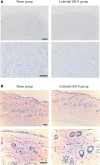Transcranial direct-current stimulation increases extracellular dopamine levels in the rat striatum
- PMID: 23596399
- PMCID: PMC3622879
- DOI: 10.3389/fnsys.2013.00006
Transcranial direct-current stimulation increases extracellular dopamine levels in the rat striatum
Abstract
Background: Transcranial direct-current stimulation (tDCS) is a non-invasive procedure that achieves polarity-dependent modulation of neuronal membrane potentials. It has recently been used as a functional intervention technique for the treatment of psychiatric and neurological diseases; however, its neuronal mechanisms have not been fully investigated in vivo.
Objective/hypothesis: To investigate whether the application of cathodal or anodal tDCS affects extracellular dopamine and serotonin levels in the rat striatum.
Methods: Stimulation and in vivo microdialysis were carried out under urethane anesthesia, and microdialysis probes were slowly inserted into the striatum. After the collection of baseline fractions in the rat striatum, cathodal or anodal tDCS was applied continuously for 10 min with a current intensity of 800 μA from an electrode placed on the skin of the scalp. Dialysis samples were collected every 10 min until at least 400 min after the onset of stimulation.
Results: Following the application of cathodal, but not anodal, tDCS for 10 min, extracellular dopamine levels increased for more than 400 min in the striatum. There were no significant changes in extracellular serotonin levels.
Conclusion: These findings suggest that tDCS has a direct and/or indirect effect on the dopaminergic system in the rat basal ganglia.
Keywords: Parkinson disease; basal ganglia; dopamine; striatum; transcranial direct current stimulation.
Figures




Similar articles
-
Electrophysiological Effects of Transcranial Direct Current Stimulation on Neural Activity in the Rat Motor Cortex.Front Neurosci. 2020 Jun 30;14:495. doi: 10.3389/fnins.2020.00495. eCollection 2020. Front Neurosci. 2020. PMID: 32714126 Free PMC article.
-
Assessment of anodal and cathodal transcranial direct current stimulation (tDCS) on MMN-indexed auditory sensory processing.Brain Cogn. 2016 Jun;105:46-54. doi: 10.1016/j.bandc.2016.03.006. Epub 2016 Apr 5. Brain Cogn. 2016. PMID: 27054908 Clinical Trial.
-
Repeated Transcranial Direct Current Stimulation Induces Behavioral, Metabolic and Neurochemical Effects in Rats on High-Calorie Diet.Front Behav Neurosci. 2018 Jan 15;11:262. doi: 10.3389/fnbeh.2017.00262. eCollection 2017. Front Behav Neurosci. 2018. PMID: 29379423 Free PMC article.
-
Tracking the Effect of Cathodal Transcranial Direct Current Stimulation on Cortical Excitability and Connectivity by Means of TMS-EEG.Front Neurosci. 2018 May 15;12:319. doi: 10.3389/fnins.2018.00319. eCollection 2018. Front Neurosci. 2018. PMID: 29867330 Free PMC article.
-
Anodal and cathodal tDCS modulate neural activity and selectively affect GABA and glutamate syntheses in the visual cortex of cats.J Physiol. 2020 Sep;598(17):3727-3745. doi: 10.1113/JP279340. Epub 2020 Jun 22. J Physiol. 2020. PMID: 32506434
Cited by
-
Therapeutic Devices for Motor Symptoms in Parkinson's Disease: Current Progress and a Systematic Review of Recent Randomized Controlled Trials.Front Aging Neurosci. 2022 Mar 29;14:807909. doi: 10.3389/fnagi.2022.807909. eCollection 2022. Front Aging Neurosci. 2022. PMID: 35462692 Free PMC article. Review.
-
The effect of HD-tDCS on brain oscillations and frontal synchronicity during resting-state EEG in violent offenders with a substance dependence.Int J Clin Health Psychol. 2023 Jul-Sep;23(3):100374. doi: 10.1016/j.ijchp.2023.100374. Epub 2023 Feb 21. Int J Clin Health Psychol. 2023. PMID: 36875007 Free PMC article.
-
New Treatment Perspectives in Adolescents With Anorexia Nervosa: The Efficacy of Non-invasive Brain-Directed Treatment.Front Behav Neurosci. 2018 Jul 20;12:133. doi: 10.3389/fnbeh.2018.00133. eCollection 2018. Front Behav Neurosci. 2018. PMID: 30083095 Free PMC article.
-
Dopamine Alters the Effect of Brain Stimulation on Decision-Making.J Neurosci. 2023 Oct 11;43(41):6909-6919. doi: 10.1523/JNEUROSCI.1140-23.2023. Epub 2023 Aug 30. J Neurosci. 2023. PMID: 37648451 Free PMC article.
-
Cathodal Transcranial Direct-Current Stimulation Selectively Decreases Impulsivity after Traumatic Brain Injury in Rats.J Neurotrauma. 2019 Oct 1;36(19):2827-2830. doi: 10.1089/neu.2019.6470. Epub 2019 Jun 17. J Neurotrauma. 2019. PMID: 31072218 Free PMC article.
References
-
- Alexander G. E., Crutcher M. D. (1990). Functional architecture of basal ganglia circuits: neural substrates of parallel processing. Trends Neurosci. 13, 266–271 - PubMed
-
- Bachmann C. G., Muschinsky S., Nitsche M. A., Rolke R., Magerl W., Treede R. D., et al. (2010). Transcranial direct current stimulation of the motor cortex induces distinct changes in thermal and mechanical sensory percepts. Clin. Neurophysiol. 121, 2083–2089 10.1016/j.clinph.2010.05.005 - DOI - PubMed
LinkOut - more resources
Full Text Sources
Other Literature Sources

